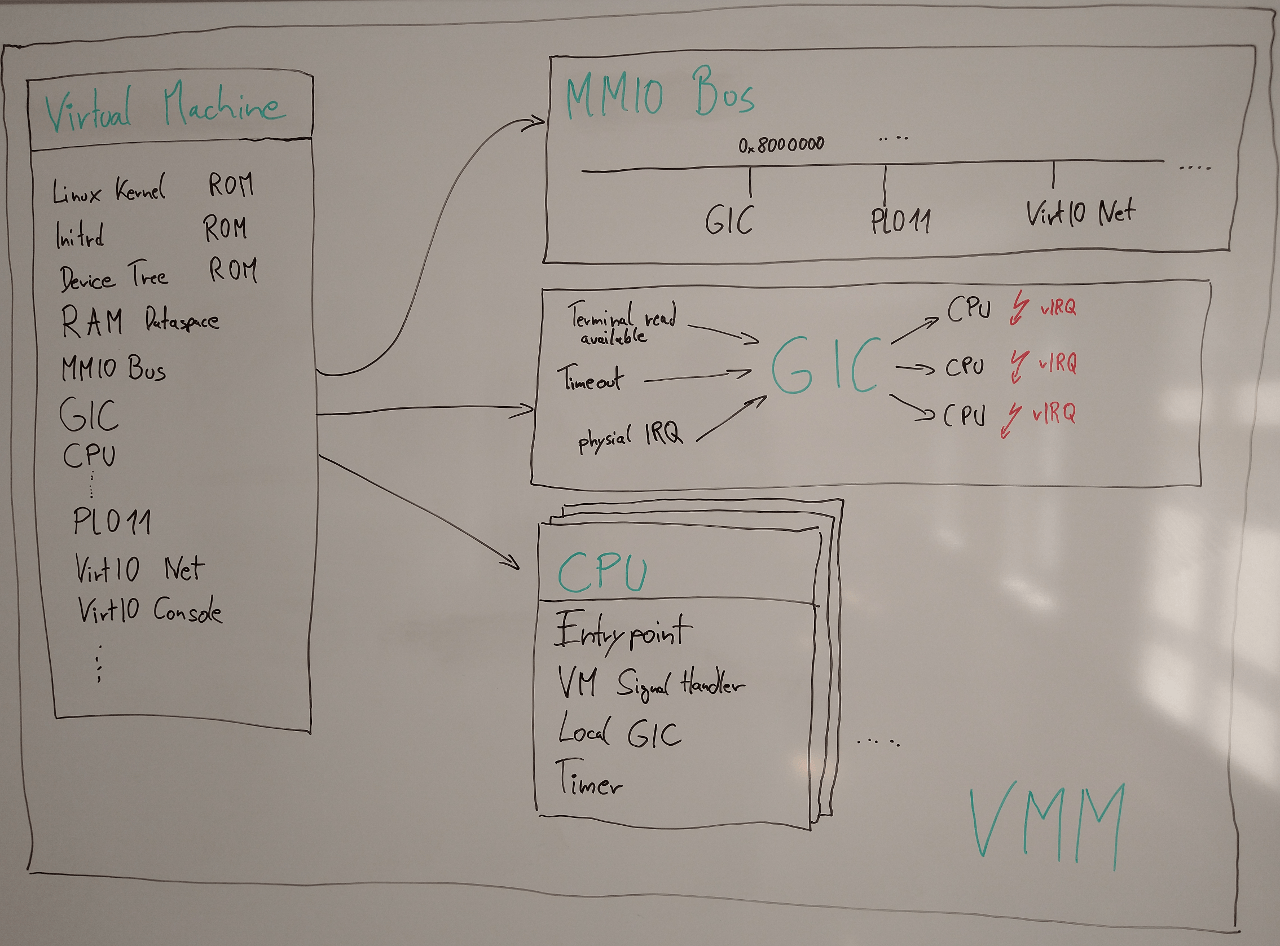Virtual Machine Monitor for ARM
In my last blog post, I described some aspects of ARMv8 hardware-assisted virtualization. The presented findings were collected during some exploration work I've done together with my colleague Alexander Boettcher during last year. As already mentioned, one outcome of this work was a new Virtual Machine Monitor (VMM) written from scratch for the ARMv8 architecture. In the meantime the VMM got extended to support recent, generic Linux kernels for ARMv8 and ARMv7, and thereby supersedes the former, outdated PoC implementation for ARMv7.
Recent interest in the VMM by people aside the Genode core developer team, motivated me to summarize the internal structure of its current implementation in this article.
Basic information
The VMM is written as a pure C++ Genode component, and gets linked to the base-library only. It comprises 2200 SLOC for the generic part including all device models, and about 300 SLOC per ARM architecture-specific branch.
It uses the following Genode-APIs:
-
Base
-
OS
-
Terminal Session (Pl011 and VirtIO Console)
-
NIC Session (VirtIO Net)
-
VM Session (CPU)
Hence, the VMM is a minimalistic component in a strict sense.
It is structured like the following figure illustrates.

|
|
Overview about VMM structure
|
When the VMM gets started, it first opens up a VM session at core. It requests ROM modules for the Linux kernel, initrd, and device-tree blob (dtb), and copies all of it to designated areas in a RAM dataspace, which serves as the VM's main memory. By attaching the RAM dataspace to the VM session via its region-map interface, the dataspace automatically becomes guest-physical memory.
All peripherals of the VM, including the Generic Interrupt Controller (GIC) model, get registered at the virtual MMIO bus that is responsible to resolve load/store VM faults on its address space. The MMIO bus translates the faults to read and write operations of the corresponding device models. All accesses to memory regions not assigned to any device model get ignored, or return zero.
The first device model that gets initialized is the GIC model that is used by almost all other devices to propagate their virtual interrupts. As next all CPU instances get initialized, and finally the Pl011 UART for debugging purposes, and VirtIO models for console and network too.
CPU model
The virtual CPU comprises an entrypoint, the CPU local part of the interrupt controller, a Generic Timer model, and all system registers that are not accessed by the guest OS directly. For instances, the access to identity, or debug registers is limited, and therefore needs to be emulated.
The entrypoints of the CPUs are the only execution contexts within the VMM. Whenever an asynchronous event wakes up such an entrypoint, it first makes sure that the corresponding virtual CPU gets not executed anymore, it then handles the last potential exception of the VM exit, and then executes the signal handler corresponding to the wakeup-event. Finally, it checks whether the virtual CPU is runnable again and in that case informs the kernel's scheduler via the VM session interface.
Asynchronous events can either be a VM exit, or a signal of some device model's backend like a Terminal receiving new characters, or a new network packet.
Let's have a look at some concrete example. For instance when a guest OS is executing a wait-for-interrupt instruction, an exception to the hypervisor gets propagated. The hypervisor saves the current CPU state to some dataspace shared in between VMM and core that represents the virtual CPU. It removes the VM's CPU context from the scheduler and sends a signal to the VMM's entrypoint associated with that CPU. The entrypoint wakes up, analyzes the VM exit, will setup an alarm according to the timer state of the virtual CPU, and then will wait for new events without re-scheduling the VM's virtual CPU, because it should not run when waiting for interrupts. Either after the timer alarm, or some other backend event triggers, a virtual interrupt will get injected via the GIC, and the virtual CPU is runnable again.
Pass-through devices
Beside the already mentioned device models, the VMM contains an abstraction called "Hw_device" that can be used to pass-through a physical peripheral into a VM. It is a template which comprises a fixed amount of physical interrupts, and memory-mapped I/O dataspaces. It eases the declaration of I/O resources that shall be used by a VM exclusively. For example, the following code:
Hw_device<2, 1> ethernet; ... ethernet.irqs(120, 121); ethernet.mmio(0xd0000000, 0x4000);
declares a peripheral with two interrupts 120 and 121, and a memory-mapped I/O region from 0xd0000000 to 0xd0004000. The corresponding I/O memory dataspace gets automatically requested, and attached to the guest physical memory. All interrupts of the device will get injected one-by-one to the virtual CPU that is assigned to the peripheral.
Given this abstraction it is easy to pass a bunch of I/O resources to a VM.


 Stefan Kalkowski
Stefan Kalkowski